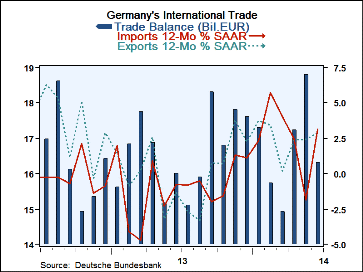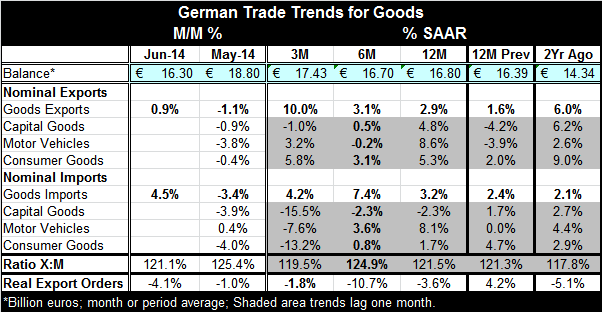 Global| Aug 08 2014
Global| Aug 08 2014German Trade Flows Seem to Revive
Summary
German activity data have been weakening recently. There is speculation that the sanctions on Russia are an important factor. But trade data for June show some rebound in German trade flows. Exports rose 0.9% in June as imports [...]
 German activity data have been weakening recently. There is speculation that the sanctions on Russia are an important factor. But trade data for June show some rebound in German trade flows. Exports rose 0.9% in June as imports advanced a strong 4.5%. The latter would seem to be signaling still strong domestic demand. Despite the pick-up in trade flows, the more robust rise in imports sets the stage for weaker German GDP growth in Q2. And, of course, year-over-year German exports and imports are still up by only about 3%.
German activity data have been weakening recently. There is speculation that the sanctions on Russia are an important factor. But trade data for June show some rebound in German trade flows. Exports rose 0.9% in June as imports advanced a strong 4.5%. The latter would seem to be signaling still strong domestic demand. Despite the pick-up in trade flows, the more robust rise in imports sets the stage for weaker German GDP growth in Q2. And, of course, year-over-year German exports and imports are still up by only about 3%.
The details for exports and imports lag the aggregate trade flows by one month. The export flows in May showed widespread declines across export categories. Imports similarly declined in May with the exception of a small rise in motor vehicle imports.
Over three months (ended in May) German exports begin to show some life as motor vehicle export and consumer goods exports show gains. Capital goods exports fall by 1% at an annual rate over three months. Among the export components, only capital goods, the area of German strength, shows a clear pattern. That pattern reveals that exports of capital goods steadily decelerate from 12-months to 6-months to 3-months. Motor vehicles exports show weaker growth over 3-months than over 12-months. Consumer goods show only slightly stronger growth over 3-months than over 12-months. Of course, overall exports that calculate flows from June in sequential periods show much stronger growth over 3-months than over 12-months. What a difference one month makes.
Similarly, imports show all 3-month flows weaker than their 12-month growth rates by a long shot. But aggregate imports, that count sequential growth rates from June, show a stronger 3-month pace than a 12-month pace.
May seems to have been an exceptionally weak month with June making up for it. Still, German exports have not come to life over the past year as they have grown slightly less than imports. The June ratio of exports to import is 121.1%, slightly lower than its 12-month earlier value of 121.5% and close to its 12-month previous ratio of 121.3%. German exports and imports have been growing in step for the last two years in this export oriented economy.
Despite the better performance of flow measures from June compared to flows measured from May, forward-looking German export orders fell by 4.1% in June. They are lower by 1.8% over 3-months and by 10.7% over 6-months, both at annualized rates. While German aggregate trade flows have put on a good show in June, there does not appear to be the trend to support the notion of revived exports nor a reason for optimism from German export orders. June looks more like it might be the aberrant result showing a pick-up in trade flows, rather than the declines in May.

Robert Brusca
AuthorMore in Author Profile »Robert A. Brusca is Chief Economist of Fact and Opinion Economics, a consulting firm he founded in Manhattan. He has been an economist on Wall Street for over 25 years. He has visited central banking and large institutional clients in over 30 countries in his career as an economist. Mr. Brusca was a Divisional Research Chief at the Federal Reserve Bank of NY (Chief of the International Financial markets Division), a Fed Watcher at Irving Trust and Chief Economist at Nikko Securities International. He is widely quoted and appears in various media. Mr. Brusca holds an MA and Ph.D. in economics from Michigan State University and a BA in Economics from the University of Michigan. His research pursues his strong interests in non aligned policy economics as well as international economics. FAO Economics’ research targets investors to assist them in making better investment decisions in stocks, bonds and in a variety of international assets. The company does not manage money and has no conflicts in giving economic advice.






